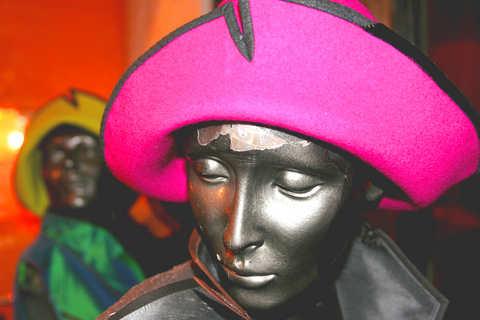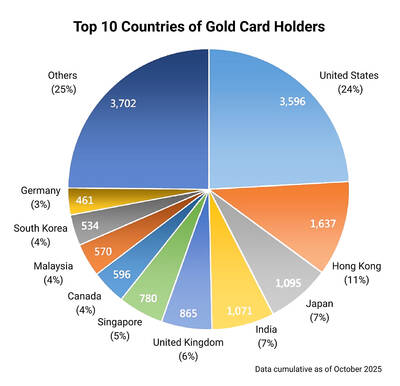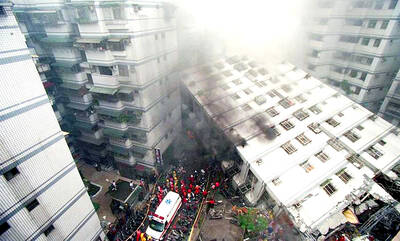Women never doubted it and even manly men wear the color. So, the big question for most fashion hounds is: What kind of pink should be worn now winter has arrived?
In Europe and relatively conservative America, pink has been a fashionable color in menswear for some time. USA Today ran a piece two years ago saying, "Lots of famous guys are in the pink when it comes to fashion." It name checked Ashton Kutcher, rappers Andre 3000 of Outkast, Sean "P. Diddy" Combs and even mentioned CNN's Larry King for his pink suspenders.
Here, the revolution took a little longer to arrive but last summer there were plenty of guys wearing suits with powder pink shirts and getting casual with bright pink T-shirts and jeans.

PHOTO: JULES QUARTLY, TAIPEI TIMES
"Before it was fine for ladies to wear pink but more difficult for guys," says Shao Chuan (小春) of cult Japanese clothing company Bathing Ape in Ximending. "There has been a change in attitudes."
Not many people know this, but the saying "pink is for girls, blue is for boys" is a relatively recent invention and bubbled up in the 1950s as pastel colors became popular. Previously, as far back as the turn of the 20th century, the reverse was true.
"The generally accepted rule is pink for the boy and blue for the girl. The reason is that pink being a more decided and stronger color is more suitable for the boy, while blue, which is more delicate and dainty, is prettier for the girl," [Ladies Home Journal, 1918].
This probably changed, according to some theorists, because the Nazis reversed the color codes by associating blue with the Virgin Mary and identified homosexuals with a pink triangle.
As the 20th century waned, resistance by men to the color relaxed, even though it became closely associated with the "cute movement" led by Hello Kitty. Following closely in her paw steps are Paris Hilton and other celebrities. Kylie Minogue returned to the stage this month after breast cancer in a fluffy pink feather headdress by designer John Galliano.
The point is, only men who are afraid of themselves fear pink. As we step into the 21st century, "pink is the new black" — once more. Gloria Vanderbilt originated the phrase in the 1960s to describe the prevalence of pink in India, as opposed to the popularity of black on New York's fashion scene.
"I think pink is always in, but if you're talking about naive, baby pink, then maybe not, that's for under 10s and over 40s. For ladies in between, it's still there, but we want it to be more sophisticated. Orangey pinks are warm and flighty, feminine but not girly. Grayish pink is cool and grungy, purple pink is sexy," says designer Robyn Hung (洪英妮).
She flies into Paris at least once a year to brainstorm with leading French trend forecasting company, Nelly Rodi, that thinks up to five years ahead and directs the retail industry's manufacturing patterns.
"Pink is very popular abroad. It's not a trend for guys to be overly masculine all the time. Sometimes they want to be cute, or catch attention. It's a perfect color to be friendly and shorten the distance between guys and girls. If you see a guy in pink you feel more relaxed than with a guy in gray. Guys in pink will brighten the whole atmosphere."
As for thinking pink this winter, Hung believes it's a color for all seasons. "It's not baby pink, we add different colors, so it's slightly darker and more dense. It's still going to be around but slightly muted, with a different tone."
According to Bathing Ape's Chuan, "Pink is cool and OK for winter because the season is darker and a bright color cheers things up."
Leading local designer Sophie Hong (洪麗芬), who has boutiques around the world, has a slightly different take on the issue. She believes each individual should wear the colors that suit, depending on age, personality, complexion, hair color and what mood you want to project.
"Different people have different needs. Also, there is a whole range for each color and this is true for pink, which can have a lot of different moods … . Don't blindly listen to what people say about fashion, rather follow your own ideas."
Pink may be cool this winter, but it's not mandatory.

Seven hundred job applications. One interview. Marco Mascaro arrived in Taiwan last year with a PhD in engineering physics and years of experience at a European research center. He thought his Gold Card would guarantee him a foothold in Taiwan’s job market. “It’s marketed as if Taiwan really needs you,” the 33-year-old Italian says. “The reality is that companies here don’t really need us.” The Employment Gold Card was designed to fix Taiwan’s labor shortage by offering foreign professionals a combined resident visa and open work permit valid for three years. But for many, like Mascaro, the welcome mat ends at the door. A

Last week gave us the droll little comedy of People’s Republic of China’s (PRC) consul general in Osaka posting a threat on X in response to Japanese Prime Minister Sanae Takaichi saying to the Diet that a Chinese attack on Taiwan may be an “existential threat” to Japan. That would allow Japanese Self Defence Forces to respond militarily. The PRC representative then said that if a “filthy neck sticks itself in uninvited, we will cut it off without a moment’s hesitation. Are you prepared for that?” This was widely, and probably deliberately, construed as a threat to behead Takaichi, though it

If China attacks, will Taiwanese be willing to fight? Analysts of certain types obsess over questions like this, especially military analysts and those with an ax to grind as to whether Taiwan is worth defending, or should be cut loose to appease Beijing. Fellow columnist Michael Turton in “Notes from Central Taiwan: Willing to fight for the homeland” (Nov. 6, page 12) provides a superb analysis of this topic, how it is used and manipulated to political ends and what the underlying data shows. The problem is that most analysis is centered around polling data, which as Turton observes, “many of these

Since Cheng Li-wun (鄭麗文) was elected Chinese Nationalist Party (KMT) chair on Oct. 18, she has become a polarizing figure. Her supporters see her as a firebrand critic of the ruling Democratic Progressive Party (DPP), while others, including some in her own party, have charged that she is Chinese President Xi Jinping’s (習近平) preferred candidate and that her election was possibly supported by the Chinese Communist Party’s (CPP) unit for political warfare and international influence, the “united front.” Indeed, Xi quickly congratulated Cheng upon her election. The 55-year-old former lawmaker and ex-talk show host, who was sworn in on Nov.